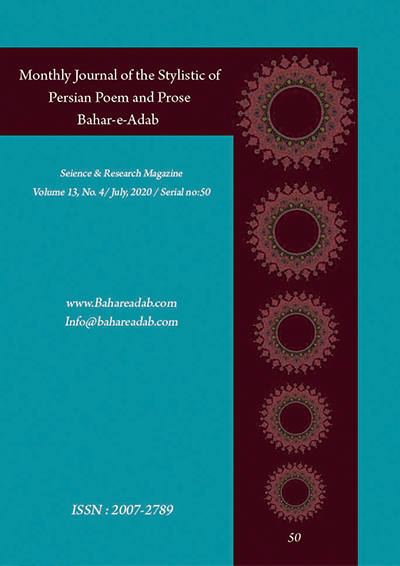- Count View : 536
- آدرس کوتاه شده مقاله: https://bahareadab.com/article_id/360
Journal of the stylistic of Persian poem and prose
volume Number 13،
number In Volume 4،
،
issue Number 50
The introduction of manuscript 0f General Divan of Taleb Ali Khan Lakhanoei, called Eishi with the passage of his lyrics style
Ziba Fallahi, Mehrdad Chatraei(Author in Charge), Maryam Mahmoodi
Abstract
Taleb
Ali Khan Lakhanoei called Eishi is a member of the poets and writers of the
style of the return of the subcontinent who has spoken poetry in both Persian
and Hindi. His general Divan remains intact in Farsi and contains 6435 verses
of poetry including elegies, festive masnavi, quatrains and other literary
forms. Eishi with the synthesis of 203 Persian lyrics in 1593 verses and 133
lyrics in the styling poetical metre of Ramal and Hazaj, he should have called
to be like the dominant philosopher GhalebDehlavi and KalimKashani; but with
detailed research and extraction of poetical metres in analytical-descriptive
ways we have achieved different results.The thirteenth century is the period of
literary return. This article, in addition to the introduction of this version;
for the first time; in lyrics style; examined his lyric poetry, lexical,
literary and intellectual qualities.The results of this research show that
Taleb Ali Khan, from the viewpoint of literary rhetoric, has a radical interest
in the simile industry specially eloquent analogy, from the point of view of
the words, the words of thetavern wordsand Sufi terms are taken for the long
meanings; He has been interested in ancient Iranian literature and culture,
though in a ghazal. In Hafez’s thought and Saeb’s mystical wisdom heis grown.
He has a philosophical and deductive mind.Sorrow in his world of thinking, is
the cosmological foundation.His lyrics have continued the Indian tradition and
in the weight of poetry, are sometimes experience the peak of the music of
Hafez Shiraz in the tendency to return style.
Keyword
Taleb Ali Khan Eishi
, General Divan
, lyrics style
, and StylMystical sonnets
- Mahmoudi, M. (2013), Ayneh Khaneh (A Study of the Theme of Mirrors in Rich Kashmiri Poetry), Bahar Adab Quarterly, Year 6, Issue 4
- Saboor, Dariush (2005), Afagh Ghazal Farsi, Tehran: Zavar
- Kahdavi, M. and Kamali, M. and Elhambakhsh, M. (2009), Statistical study of the weights of Bidel Dehlavi andComparison with the weight of Persian lyric and Indian style, Journal of Literary Techniques, Scientific Research, University of Isfahan, First Year, No. 1,p107
- Najarian, M. and Ghazanfari, M. (2013), Statistical study of the weights of the dominant lyric poems of Dehlavi, Journal of Literary Technologies, University of Isfahan, Fifth year, No. 2, p. 149
- Nowruzi, Z and Hosseinzadeh, M (2013), A Study of Ganjavi Military Ghazals Style, Bahar Adab Quarterly, Volume 6, Number 3, Page 515
- Karami, M and Moradi, M (2010), A study of the types of weight in the sonnets of poets who grew up in the tenth, eleventh and twelfth, Journal of Literary Techniques, Second Year, No. 2, p. 18
- Farshidvard, Khosrow (1999), Stylistics of Persian Poetry from Rudaki to Shamloo, Tehran: Jami
- Langroudi, Shams (1990), Indian style and Kaleem Kashani, Tehran:Markaz
- Gholamrezaei, Mohammad (1998), Stylistics of Persian Poetry from Rudaki to Shamloo, Tehran: Jami
- Shamisa, Sirus (2007), The Course of Ghazal in Persian Poetry, Tehran: Alam
- Barzegar Khaleghi, Mohammad Reza (2003), Hafez Candy Branch, Tehran: Zavar
- Qaisar Amrahvi, H (1960), Talib Ali Eishi (article in Urdu), Journal of Education, Dar al-Musnafin, the Greatest City of IndiaNo. 4, Volume 5, Page 261
- Shamisa, Sirus (2008), Farhang-e Asharat, Tehran: Mitra
- Shafiee Kadkani, Mohammad Reza (2000), Poetry Music, Tehran: Agah

